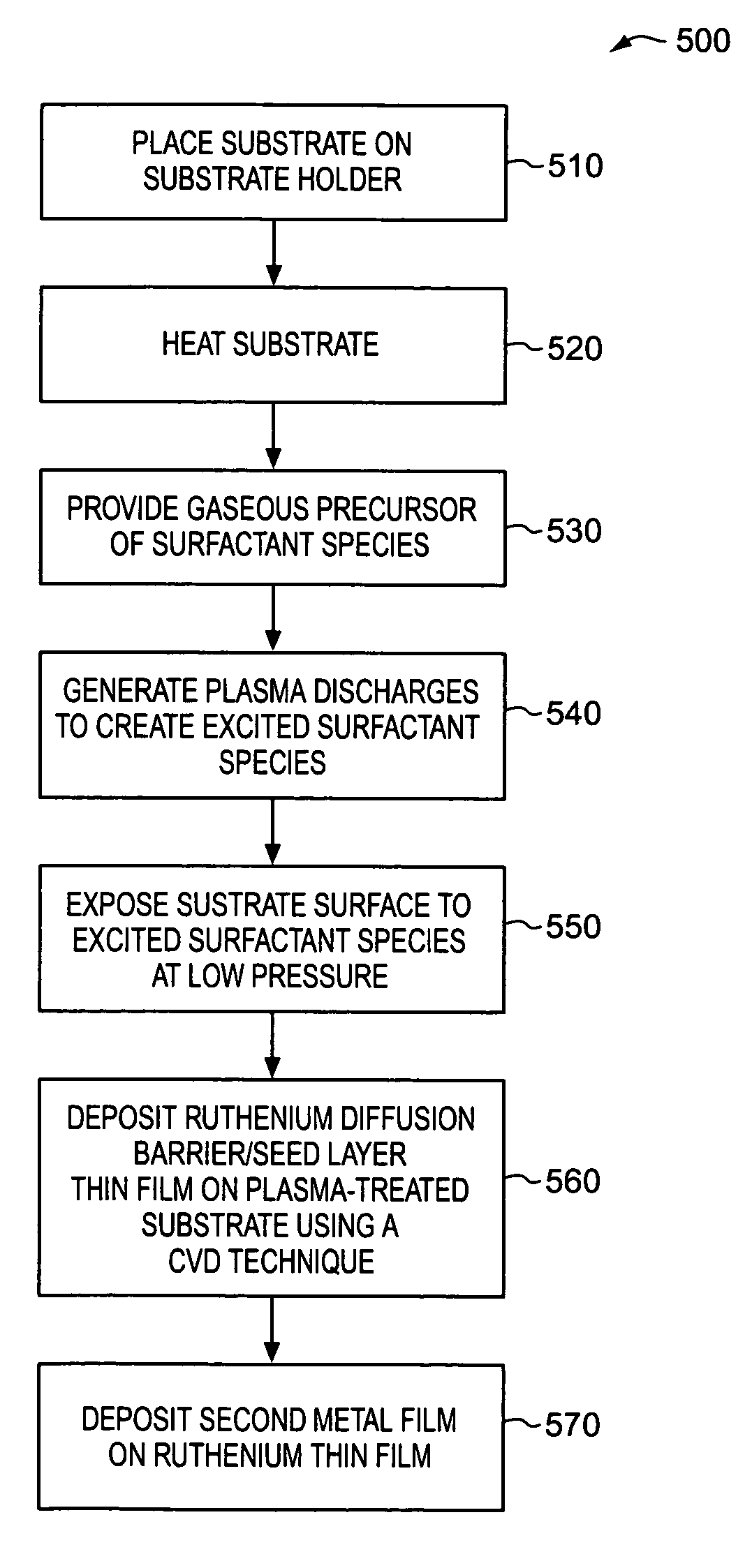Surface treatment using iodine plasma to improve metal deposition
a surface treatment and metal deposition technology, applied in the field of chemical vapor deposition of metal, can solve the problems of difficult physical vapor deposition to line holes and trenches with uniform and conformal thin films of integrated circuit materials, ruthenium and ruthenium, and physical vapor deposition techniques are often unsatisfactory for obtaining good quality, continuous, conformal thin films, etc., to reduce the time required for metal nucleation and improve metal deposition
- Summary
- Abstract
- Description
- Claims
- Application Information
AI Technical Summary
Benefits of technology
Problems solved by technology
Method used
Image
Examples
example 1
[0077]A series of 200 mm silicon semiconductor wafers having a thermal silicon dioxide, SiO2, substrate surface were plasma-treated in accordance with the invention. Each untreated wafer was placed on a heated substrate holder in vacuum chamber having an internal free volume of approximately 20 liters. The pressure of the chamber was maintained at about 300 mTorr. The wafer was heated to a temperature in a range of about from 300° C. to 360° C. Argon gas was flowed continuously via an inlet showerhead through the vacuum chamber at flow rate of about 250 sccm. A dose of ethyliodine (C2H5I) surfactant precursor gas having a volume of 25 cc at 157 Torr pressure was flowed during a treatment time of approximately 20 seconds at an approximately uniform flowrate (i.e., about 15 sccm ethyliodine) into the inlet showerhead, where it mixed with the argon gas and the mixture flowed into the vacuum chamber. During the 20-second treatment time, 300 W HF-RF power was applied at 13.56 MHz to the ...
example 2
[0081]A series of 200 mm silicon semiconductor wafers having a thermal silicon dioxide, SiO2, substrate surface were plasma-treated in accordance with the invention as in Example 1.
[0082]After plasma treatment, a conventional ALD technique was conducted to deposit a thin film of ruthenium metal, Ru, on each of several treated wafers. The ALD technique was conducted on different wafers at one of two different temperatures in the reaction chamber, 330° C. and 360° C. The ALD technique was varied between wafers by varying the total number of ALD deposition cycles conducted with a given wafer. The total number of ALD deposition cycles was repeated up to three hundred times to deposit a thin film of ruthenium. The MOCVD apparatus used in Example 1 was modified for the ALD processes.
[0083]The conventional ALD deposition cycle used included four stages: a ruthenium-containing precursor dosage; a first, post-precursor inert-gas purge stage; a surface-reactivation stage, in which an oxidizin...
PUM
| Property | Measurement | Unit |
|---|---|---|
| thickness | aaaaa | aaaaa |
| thickness | aaaaa | aaaaa |
| thickness | aaaaa | aaaaa |
Abstract
Description
Claims
Application Information
 Login to View More
Login to View More - R&D
- Intellectual Property
- Life Sciences
- Materials
- Tech Scout
- Unparalleled Data Quality
- Higher Quality Content
- 60% Fewer Hallucinations
Browse by: Latest US Patents, China's latest patents, Technical Efficacy Thesaurus, Application Domain, Technology Topic, Popular Technical Reports.
© 2025 PatSnap. All rights reserved.Legal|Privacy policy|Modern Slavery Act Transparency Statement|Sitemap|About US| Contact US: help@patsnap.com



